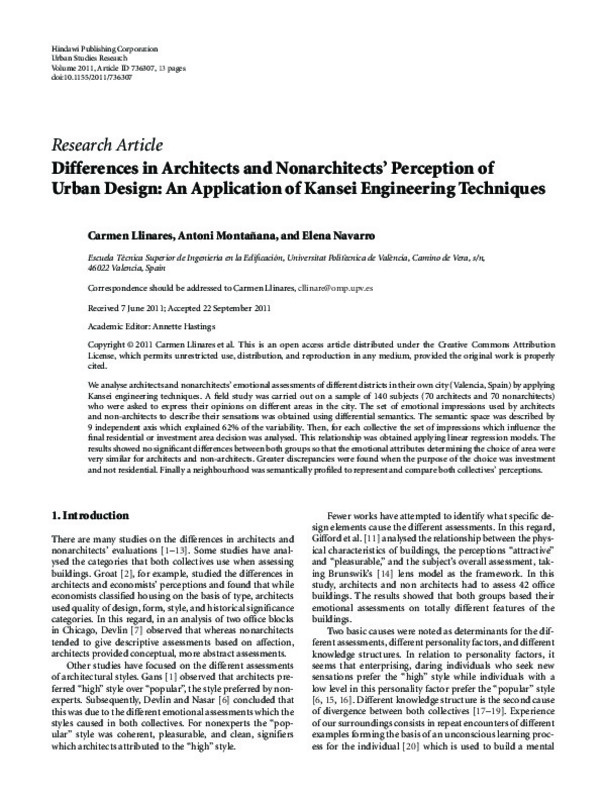Groat, L. (1982). Meaning in post-modern architecture: An examination using the multiple sorting task. Journal of Environmental Psychology, 2(1), 3-22. doi:10.1016/s0272-4944(82)80002-9
Duffy, M., Bailey, S., Beck, B., & Barker, D. G. (1986). Preferences in Nursing Home Design. Environment and Behavior, 18(2), 246-257. doi:10.1177/0013916586182006
Devlin, K., & Nasar, J. L. (1989). The beauty and the beast: Some preliminary comparisons of ‘high’ versus ‘popular’ residential architecture and public versus architect judgments of same. Journal of Environmental Psychology, 9(4), 333-344. doi:10.1016/s0272-4944(89)80013-1
[+]
Groat, L. (1982). Meaning in post-modern architecture: An examination using the multiple sorting task. Journal of Environmental Psychology, 2(1), 3-22. doi:10.1016/s0272-4944(82)80002-9
Duffy, M., Bailey, S., Beck, B., & Barker, D. G. (1986). Preferences in Nursing Home Design. Environment and Behavior, 18(2), 246-257. doi:10.1177/0013916586182006
Devlin, K., & Nasar, J. L. (1989). The beauty and the beast: Some preliminary comparisons of ‘high’ versus ‘popular’ residential architecture and public versus architect judgments of same. Journal of Environmental Psychology, 9(4), 333-344. doi:10.1016/s0272-4944(89)80013-1
Stamps, A. E. (1991). Public Preferences for High Rise Buildings: Stylistic and Demographic Effects. Perceptual and Motor Skills, 72(3), 839-844. doi:10.2466/pms.1991.72.3.839
Gifford, R., Hine, D. W., Muller-Clemm, W., Reynolds, D. J., & Shaw, K. T. (2000). Decoding Modern Architecture. Environment and Behavior, 32(2), 163-187. doi:10.1177/00139160021972487
Akalin, A., Yildirim, K., Wilson, C., & Kilicoglu, O. (2009). Architecture and engineering students’ evaluations of house façades: Preference, complexity and impressiveness. Journal of Environmental Psychology, 29(1), 124-132. doi:10.1016/j.jenvp.2008.05.005
Purcell, A. T. (1986). Environmental Perception and Affect. Environment and Behavior, 18(1), 3-30. doi:10.1177/0013916586181001
Purcell, A. T. (1987). The relationship between buildings and behaviour. Building and Environment, 22(3), 215-232. doi:10.1016/0360-1323(87)90010-2
Purcell, A. T., & Nasar, J. L. (1992). Experiencing other people’s houses: a model of similarities and differences in environmental experience. Journal of Environmental Psychology, 12(3), 199-211. doi:10.1016/s0272-4944(05)80135-5
Lewicki, P., Hill, T., & Bizot, E. (1988). Acquisition of procedural knowledge about a pattern of stimuli that cannot be articulated. Cognitive Psychology, 20(1), 24-37. doi:10.1016/0010-0285(88)90023-0
Mulder, C. H. (1996). Housing choice: Assumptions and approaches. Netherlands Journal of Housing and the Built Environment, 11(3), 209-232. doi:10.1007/bf02496589
Ellen, I. G., & Turner, M. A. (1997). Does neighborhood matter? Assessing recent evidence. Housing Policy Debate, 8(4), 833-866. doi:10.1080/10511482.1997.9521280
Nagamachi, M. (1995). Kansei Engineering: A new ergonomic consumer-oriented technology for product development. International Journal of Industrial Ergonomics, 15(1), 3-11. doi:10.1016/0169-8141(94)00052-5
Jindo, T., Hirasago, K., & Nagamachi, M. (1995). Development of a design support system for office chairs using 3-D graphics. International Journal of Industrial Ergonomics, 15(1), 49-62. doi:10.1016/0169-8141(94)00056-9
Matsubara, Y., & Nagamachi, M. (1997). Hybrid Kansei engineering system and design support. International Journal of Industrial Ergonomics, 19(2), 81-92. doi:10.1016/s0169-8141(96)00005-4
Llinares, C., & Page, A. (2007). Application of product differential semantics to quantify purchaser perceptions in housing assessment. Building and Environment, 42(7), 2488-2497. doi:10.1016/j.buildenv.2006.06.012
Streiner, D. L. (2003). Starting at the Beginning: An Introduction to Coefficient Alpha and Internal Consistency. Journal of Personality Assessment, 80(1), 99-103. doi:10.1207/s15327752jpa8001_18
Llinares, C., & Page, A. F. (2008). Differential semantics as a Kansei Engineering tool for analysing the emotional impressions which determine the choice of neighbourhood: The case of Valencia, Spain. Landscape and Urban Planning, 87(4), 247-257. doi:10.1016/j.landurbplan.2008.06.006
Herzog, T. R. (1992). A cognitive analysis of preference for urban spaces. Journal of Environmental Psychology, 12(3), 237-248. doi:10.1016/s0272-4944(05)80138-0
Nasar, J. L. (1990). The Evaluative Image of the City. Journal of the American Planning Association, 56(1), 41-53. doi:10.1080/01944369008975742
Jindo, T., & Hirasago, K. (1997). Application studies to car interior of Kansei engineering. International Journal of Industrial Ergonomics, 19(2), 105-114. doi:10.1016/s0169-8141(96)00007-8
Ishihara, S., Ishihara, K., Nagamachi, M., & Matsubara, Y. (1997). An analysis of Kansei structure on shoes using self-organizing neural networks. International Journal of Industrial Ergonomics, 19(2), 93-104. doi:10.1016/s0169-8141(96)00006-6
Shimizu, Y., & Jindo, T. (1995). A fuzzy logic analysis method for evaluating human sensitivities. International Journal of Industrial Ergonomics, 15(1), 39-47. doi:10.1016/0169-8141(95)91249-a
[-]









